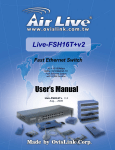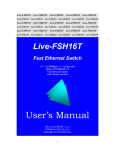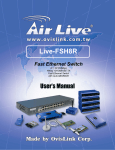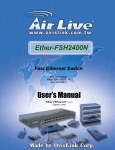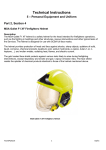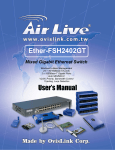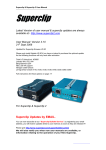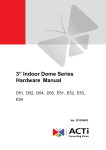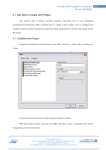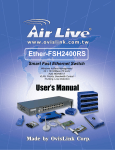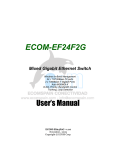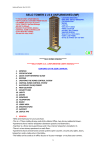Download Live-FSH16T+ Fast Ethernet Switch Product Features
Transcript
Live-FSH16T+ Fast Ethernet Switch 16 × 10/100Mbps NWay 10/100BASE-TX Fast Ethernet Switch with VLAN function User’s Manual Live-FSH16T+ V.2.1 October , 2002 Copyright © OvisLink Corp. Trademarks All rights reserved. OvisLink and OvisLink Logo are registered trademarks of OvisLink Corp. Other product names and company names are trademarks or registered trademarks of their respective owners. FCC Warning This equipment has been tested and found to comply with the requirements for a Class A digital device, pursuant to Part 15 of the FCC Rules. These requirements are designed for reasonable protection against harmful interference when the equipment operating in a commercial environment. This equipment can generate and radiate electromagnetic energy and, if not installed and used in accordance with this guide, may cause significant interference with radio communication. Operation of this equipment in a residential area is likely to cause interference to household appliances, in which case the user will be required to amend at his or her own expense. CE Mark Warning This is a Class A product. In a domestic environment, this product may cause radio interference, in which case the user may be required to take adequate preventive measures. Disclaimer Contents in this manual are subject to changes without prior notice. About this User’s Manual This User’s Manual aims at helping users to know the key features of Live-FSH16T+ Fast Ethernet Switch and to install it in a 10/100BASE-TX Fast Ethernet Local Area Network (LAN). Table of Contents Table of Contents TABLE OF CONTENTS ........................................................................................I 1 PRODUCT OVERVIEW ........................................................................1 Introduction....................................................................................................................... 1 16× 10/100Mbps ports Fast Ethernet Switch with Per-port VLAN function ................. 1 Port-based VLAN for Instant Connectivity and Workgroup Privacy............................. 1 Per-port VLAN Configuration via a selection switch..................................................... 1 Store-and-Forward Architecture against Packet Loss..................................................... 1 Active Flow Control ....................................................................................................... 2 Full Wire Speed .............................................................................................................. 2 System/Port Status Information at a Glance ................................................................... 2 What is VLAN? ................................................................................................................. 2 Defining VLAN .............................................................................................................. 2 Port-based VLAN ........................................................................................................... 2 Table Maintenance via Signaling.................................................................................... 3 Product Features............................................................................................................... 4 Basic Features ................................................................................................................. 4 Advanced Features.......................................................................................................... 4 2 PREPARATION BEFORE INSTALLATION.........................................5 Unpack the Package.......................................................................................................... 5 The Front Panel................................................................................................................. 6 The Rear Panel.................................................................................................................. 6 i Live-FSH16T+ Fast Ethernet Switch User’s Manual V2.1 Table of Contents Station Ports (Port #1 to #16).......................................................................................... 6 DC Power Jack................................................................................................................ 6 VLAN mode switch ........................................................................................................ 7 3 INSTALLATION OF THE SWITCH.......................................................8 Quick Installation.............................................................................................................. 8 3 Steps to Quick Installation ........................................................................................... 8 Desktop Installation .......................................................................................................... 8 Installation on Wall........................................................................................................... 9 Cabling Requirements ...................................................................................................... 9 Cable requirement for 100BASE-TX Port...................................................................... 9 Straight-through cabling ................................................................................................. 9 Connecting to Power....................................................................................................... 11 4 EXPANDING YOUR NETWORK ........................................................12 Connectivity Rules .......................................................................................................... 12 10 Mbps Connection (10BASE-T) ............................................................................... 12 Twisted-pair 100Mbps Connection (100BASE-TX) .................................................... 12 Connecting to another Switch/Hub ............................................................................... 13 Straight-through Cable Connection for Switch-to-Switch/hub Connection ................. 13 Transmission Modes ....................................................................................................... 14 Station Ports (10/100BASE-TX Transmission)............................................................ 14 LAN Micro segmentation through Switching Technology.......................................... 14 Benefits of VLAN ............................................................................................................ 14 Advantage of VLAN Switching over Routing.............................................................. 14 Virtual Workgroups ...................................................................................................... 15 Centralized Server Farms.............................................................................................. 15 ii Live-FSH16T+ Fast Ethernet Switch User’s Manual V2.1 Table of Contents Higher Performance and Reduced Latency .................................................................. 15 Ease of Administration ................................................................................................. 15 Saving Costs.................................................................................................................. 15 Routing between VLANs.............................................................................................. 15 Security ......................................................................................................................... 16 Reduction of Routing for Broadcast Containment........................................................ 16 Infrastructural VLANs .................................................................................................. 16 5 LED INDICATORS..............................................................................18 Comprehensive LEDs ..................................................................................................... 18 System LED .................................................................................................................. 18 Station Port LEDs ......................................................................................................... 18 Power LED ...................................................................................................................... 18 VLAN LEDs .................................................................................................................... 19 Station Port LEDs ........................................................................................................... 19 Link/Act LED ............................................................................................................... 19 FDX/Col LED............................................................................................................... 19 100M ............................................................................................................................. 19 6 VLAN CONFIGURATIONS....................................................................20 VLAN Mode Switch........................................................................................................ 20 VLAN Modes................................................................................................................... 20 VLAN1: 15-VLANs mode ........................................................................................... 20 VLAN Example using 15-VLANs mode...................................................................... 21 VLAN2: 14-VLANs mode ........................................................................................... 22 VLAN Example using 14-VLANs mode...................................................................... 22 APPENDIX A: PRODUCT SPECIFICATIONS .................................................23 APPENDIX B TROUBLESHOOTING...............................................................25 iii Live-FSH16T+ Fast Ethernet Switch User’s Manual V2.1 Table of Contents Figures Fig. 2-1 Package Content................................................................................................ 5 Fig. 2-2 Front Panel ........................................................................................................ 6 Fig. 2-3 Rear Panel ......................................................................................................... 7 Fig. 2-4 VLAN mode switch .......................................................................................... 7 Fig. 3-1 Desktop installation........................................................................................... 8 Fig. 3-2 Bottom View of the Switch (showing mounting holes).................................... 9 Fig. 3-3 10/100BASE-TX pin assignments for RJ-45 connector ................................. 10 Fig. 3-4 Pin assignments for straight-through cabling.................................................. 10 Fig 3-5 Connecting the Switch to power outlet ............................................................ 11 Fig. 4-2 Routing between VLANs through a layer-3 Switch/Router ......................... 16 Fig. 5-1 Front-panel LED indicators............................................................................ 18 Fig 6-1: VLAN Mode Switch ....................................................................................... 20 Figure 6-2 VLAN1: 15-VLANs Mode Example........................................................... 21 Figure 6-3 VLAN2: 14-VLANs Mode Example........................................................... 22 iv Live-FSH16T+ Fast Ethernet Switch User’s Manual V2.1 Table of Contents Tables Table 3-1 Cabling type for 10BASE-T/100BASE-TX................................................. 10 Table 5-1 Station Port LEDs......................................................................................... 19 Table 5-1: 15–VLANs mode ......................................................................................... 21 Table 5-2: 14–VLANs mode ......................................................................................... 22 v Live-FSH16T+ Fast Ethernet Switch User’s Manual V2.1 1 Product Overview 1 Product Overview Introduction 16× 10/100Mbps ports Fast Ethernet Switch with Per-port VLAN function Live-FSH16T+ Fast Ethernet Switch is an auto-sensing and auto-negotiating 10/100ABSE-TX Fast Ethernet Switch with VLAN and Priority capability. Its sixteen 10/100Mbps station ports provide 10/100Mbps connections to Ethernet/Fast Ethernet network. Live-FSH16T+’s unique switching fabric provides full wire speed for all ports. With auto-sensing, Live-FSH16T+ automatically detects the speed of the devices you plug into, and routes the incoming data to its destination. Its auto-negotiating function allows existing devices running at different speeds to communicate easily within the same network. Live-FSH16T+ also supports VLAN and Priority functions as briefly described in the following sections: Port-based VLAN for Instant Connectivity and Workgroup Privacy VLAN ensures instant connectivity and workgroup privacy. Since each station port can be configured to whichever VLAN group, it offers utmost flexibility for workgroup assignment as to ensure workgroup privacy. For those ports that join a VLAN, it offers instant connectivity without further configuration efforts from network administrator. Members of a same VLAN group will be included within a same broadcast domain, and will feel exactly as they are on the same network segment (though they might not belong to the same physical network segment). Per-port VLAN Configuration via a selection switch With a selection switch in the back panel, user can set the switch in operate in either 14 or 15-VLANs mode. In “14-VLANs mode”, every port is in its own VLAN group sharing Port 1 and Port 2. In “15-VLANs mode”, every port is in its own VLAN group sharing Port 2. Store-and-Forward Architecture against Packet Loss When network is under heavy traffic, the shared memory buffer in the switching devices might yield incorrect detections due to overfed memory buffer. This setback can happen either when data is transmitted in IEEE802.3x Full Duplex or Back Pressure Flow Control mode. To solve this problem, Live-FSH16T+ utilizes a fixed memory buffer allocation with Store-and-forward transmission to ensure an effective buffer allocation for each port. Store-and-forward transmission controls data flow from transmitting to receiving nodes with the receiving buffer threshold adjusted to an optimal value, thus guaranteeing against all possible packet losses. 1 Live-FSH16T+ Fast Ethernet Switch User’s Manual V2.1 1 Product Overview Active Flow Control Live-FSH16T+ Fast Ethernet Switch implements in full duplex mode a flow control that is compliant with the IEEE 802.3x standard. While in half duplex mode, it employs an optional Back Pressure Flow Control to stall the incoming data when port buffers are saturated. With this flow control mechanism, it can be ensured that frames dropped during transmission are reduced to a minimum. Full Wire Speed Live-FSH16T+’s Full Wire Speed feature provides high-end performance for departmental and workgroup environments at a fraction of the cost of similar devices. Typically, this feature was found only in high-end switches designed to handle huge corporate networks. With bandwidth needs and network efficiency concerns, Live-FSH16T+’s switching fabric design is the perfect answer for bandwidth enhancement solution. System/Port Status Information at a Glance There are 2 sets of LEDs on the front panel: System LEDs and Station Port LEDs. The System LEDs consist of the Power, VLAN1, and VLAN2 LEDs. Power LED shows Power On/Off status of the switch. The VLAN1(15-VLANs) and VLAN2(14-VLANs) show the VLAN configuration status The Station Port LEDs reveal the link status, half/full duplex transmission, 10/100Mbps speed mode and the collision status of each station port. For detailed LED information, refer to Chapter 5, LED Indicators. What is VLAN? Defining VLAN What is VLAN? Since VLAN solutions and implementations are still very vendor-specific, to define precisely what VLANs will certainly arouse controversy. Nevertheless, most would agree that a VLAN can roughly be equated as a broadcast domain. More specifically, VLANs can be seen as a group of end stations, perhaps on multiple physical LAN segments, which are not constrained by their physical location and can communicate as if they were on a common LAN. There are several ways to define VLAN membership: port grouping, frame tagging, MAC-layer grouping, network-layer grouping, IP multicast grouping, etc. Live-FSH16T+ utilizes port-grouping (port-based VLAN) for the implementation of VLAN in your network. Port-based VLAN Live-FSH16T+ simplified the VLAN setup by implementing the most common used VLAN configuration with a selection switch. The two VLAN modes of Live-FSH16T+ allows users to put each port in separate VLAN groups while able to share common resources. Users can choose either 14-VLANs or 15-VLANs group. In 14-VLANs mode, each port is in its own VLAN group with Port 1 and Port 2 as sharing ports. In 15-VLANs mode, each port is in its own VLAN group with Port 2. The sharing ports are ports that are shared by all VLAN groups for common resources such 2 Live-FSH16T+ Fast Ethernet Switch User’s Manual V2.1 1 Product Overview as Internet connection, servers, or connection to another switch. Table Maintenance via Signaling When an end-station broadcasts its first frame, the switch resolves the end-station’s attached port with its VLAN membership in cached address tables. As VLAN membership changes, these address tables can be manually updated by a system administrator at a management console. 3 Live-FSH16T+ Fast Ethernet Switch User’s Manual V2.1 1 Product Overview Live-FSH16T+ Fast Ethernet Switch Product Features Basic Features ! ! Fast Ethernet Switch with sixteen 10/100Mbps station ports Fully compliant with Ethernet/Fast Ethernet standards: - IEEE 802.3 (10 BASE-T Ethernet) - IEEE 802.3u (100 BASE-TX Fast Ethernet) - IEEE 802.1q VLAN - ANSI/IEEE Std 802.3 NWay auto-negotiation ! Fixed-port configuration: ! Easy plug-and-play installation Port -based Home VLAN function for network topology security configuration (Ether-FSH16T+ can be configured as 14 VLANs [Port 3 to Port 16 is in its own VLAN group sharing Port 1 and Port 2], or configured as 15 VLANs [Each port in its own VLAN group sharing Port 2 ] ) VLAN1/VLAN2 Selection button to enable/disable 15-VLANs/14-VLANs configuration Store and Forward transmission to prevent packet loss Half/Full Duplex function for all 10/100BASE-TX stations ports Auto-sensing and auto-MDI/MDIX function for all 10/100BASE-TX station ports Active Flow control to minimize frame drops - 16 × 10/100 Mbps auto-sensing and auto-negotiating ports (Port #1 ~ 16) ! ! ! ! ! ! - Half Duplex: Back Pressure control - Full Duplex: IEEE 802.3x compliant flow control ! Comprehensive LED indicators for system/port status monitoring: System LEDs - Power (green) LED to indicate power on/off status - VLAN1 (yellow) LEDs to indicate the status of 15-VLANs configuration - VLAN2 (yellow) LEDs to indicate the status of 14-VLANs configuration Station Port LEDs (for port 1 ~ port16) - Link/Act (green) LEDsto indicate linking status and activity in 10/100Mpbs mode - FDX/Col (yellow) LEDs to indicate Half/Full Duplex transmission and collision status - 100M (red) LEDs to indicate 100 Mbps speed ! Cabling distance up to 100 meters for twisted-pair cable Advanced Features VLAN ! ! Port-based VLAN support: Port 1 and Port 2 can be configured as overlapping port via VLAN mode switch on the back panel. 4 Live-FSH16T+ Fast Ethernet Switch User’s Manual V2.1 2 Preparation before Installation 2 Preparation before Installation Unpack the Package Before you begin the installation of Live-FSH16T+ Fast Ethernet Switch, make sure that you have all the necessary accessories that come with your package. Follow the steps below to unpack your package contents: 1. 2. 3. Clear out an adequate space to unpack the package carton. Open the package carton and take out the contents carefully. Put back all the shipping materials such as plastic bag, paddings and linings into the package carton and save them for future transport need. After unpacking and taking out the entire package contents, you should check whether you have got the following items: ⌧ ⌧ ⌧ ⌧ Live-FSH16T+ Fast Ethernet Switch One AC power adapter Rubber pads and stacking clip Support CD-ROM (The PDF version of this User’s Manual can be found within) If any of these above items is missing or damaged, please contact your local dealer for replacement. Fig. 2-1 Package Content 5 Live-FSH16T+ Fast Ethernet Switch User’s Manual V2.1 2 Preparation before Installation The Front Panel The front panel is where you can find the LED indicators. For information concerning LED indicators, please refer to Chapter 5, LED Indicators. Power LED Station Port LEDs VLAN LEDS Fig. 2-2 Front Panel The Rear Panel The rear panel is where you can locate the DC power jack, the 16 10/100Mbps station ports. For the technical specifications of the ports, please refer to Appendix A, Product Specifications for detailed information. Station Ports (Port #1 to #16) Live-FSH16T+ Fast Ethernet Switch is equipped with 16 10/100Mbps auto-sensing and auto-negotiating ports. You can use these ports to connect to end stations, servers or other networking devices. DC Power Jack The DC Power Jack is where you should connect the DC power adapter chord. Power Connector Station Ports VLAN Mode Switch 6 Live-FSH16T+ Fast Ethernet Switch User’s Manual V2.1 2 Preparation before Installation Fig. 2-3 Rear Panel VLAN mode switch THE VLAN mode switch is where you can select the VLAN mode for the switch $ VLAN1: The switch is operating in 15-VLAN mode. Each port is in its own VLAN group sharing Port 2 $ VLAN2: The switch is operating in 14-VLAN mode. Each port is in its own VLAN group sharing Port 1 and Port 2 $ OFF: The switch’s VLAN function is off. Fig. 2-4 VLAN mode switch 7 Live-FSH16T+ Fast Ethernet Switch User’s Manual V2.1 3 Installation of the Switch 3 Installation of the Switch Quick Installation Live-FSH16T+ Fast Ethernet Switch is fully compliant with 10/100BASE-TX Fast Ethernet standards. Live-FSH16T+ also features VLAN function. The VLAN function is primarily designed as an ideal solution to enhance your workgroup/corporate network performance with instant connectivity and workgroup security. With a selection switch in the back panel, user can set the switch in operate in either 14 or 15-VLANs mode. In “14-VLANs mode”, every port is in its own VLAN group sharing Port 1 and Port 2. In “15-VLANs mode”, every port is in its own VLAN group sharing Port 2. 3 Steps to Quick Installation Step 1. Power on the Switch. Step 2. Connect network devices to the Switch: connect either workstation, server, switch, bridge or router to the station port (10/100BASE-TX), using 100 ohm unshielded twisted pair (category 5 UTP) or shielded twisted-pair (STP) cable. Step 3. Select the VLAN mode: Use the VLAN-mode switch in the back panel to choose the VLAN mode. The default VLAN setting is OFF. For the configuration details, please refer to Chapter 6 specifically. Desktop Installation Live-FSH16T+ Fast Ethernet Switch has four rubber pads attached on each corner of its underside. These pads serve as cushionings against vibration and prevent the switch from sliding off its position. They also allow adequate ventilation space when you place the switch on top of another device. Fig. 3-1 Desktop installation 8 Live-FSH16T+ Fast Ethernet Switch User’s Manual V2.1 3 Installation of the Switch Installation on Wall Live-FSH16T+ Fast Ethernet Switch can be mounted on a wall with wall anchors and screws. To mount the Switch on wall, please follow the steps below: % % % % Drill two holes, the distance between both of which should be 9 cm (such as the illustration below). Insert wall anchors into these two holes. Drive the screws into the top of the wall anchors. Mount Live-FSH16T+ on the screws. 9 cm Fig. 3-2 Bottom View of the Switch (showing mounting holes) Cabling Requirements Live-FSH16T+ Fast Ethernet Switch is primarily designed as a central switching device to provide 10/100Mbps bandwidth to your Ethernet/Fast Ethernet LAN. Cable requirement for 100BASE-TX Port Those 16 RJ-45 station ports (MDI-X) all require Cat. 5 twisted-pair UTP/STP cable for connection. When configuring within the 10/100BASE-TX cabling architecture, the cable distance should be within 100m. The following table summarizes the cable requirement for 10/100BASE-TX connection: 10BASE-T 100BASE-TX 100 ohm Category 3, 4, 5 UTP/STP cable 100 ohm Category 5 UTP/STP cable Straight-through cabling 9 Live-FSH16T+ Fast Ethernet Switch User’s Manual V2.1 3 Installation of the Switch Under most conditions, the 16 station ports on the Switch accept normal, straight-through cables, i.e., standard UTP/STP cables, which are the only ones that can be used with a RJ-45 connector interface. Normally, 10BASE-T networks require a straight-through Cat. 3, 4, 5 UTP/STP cabling system. The cabling system could be found in most existing Ethernet network installations. 100/100BASE-TX networks require Cat. 5 UTP/STP cabling system. The pin assignments for a straight-through cable are shown in Figure 3-5 and 3-6. Fig. 3-3 10/100BASE-TX pin assignments for RJ-45 connector Fig. 3-4 Pin assignments for straight-through cabling Note: While connectingLive-FSH16T+ to other hub/switch, you don’t have to use a crossover cable for connection, since Live-FSH16T+ performs auto-crossing over by its Auto-MDI, Auto-MDI-X function. Simply use the straight-through cable for all types of 100BASE-TX connections, either to a PC or to a networking device such as other hub or switch. The table below describes when to use straight-through or crossover cable: Connection Specification Station Port 10BASE-T/100BASE-T RJ-45 Interface Cable to Use To an end station Straight-through twisted-pair cable Straight-through twisted-pair cable 100 meters To a hub/switch Maximum Distance Table 3-1 Cabling type for 10BASE-T/100BASE-TX 10 Live-FSH16T+ Fast Ethernet Switch User’s Manual V2.1 3 Installation of the Switch Connecting to Power Live-FSH16T+ is accompanied with an external power adapter unit, which is specifically designed for the line voltage and the type of AC outlet used in your location. This power adapter provides the voltage, amperage, and polarity required by the Switch ([email protected], inside positive, outside negative) and is outfitted with the correct type of barrel connector for the DC power jack on the rear panel. After verifying that the DC power adapter cord is suitable for use, just plug the male end of the DC power adapter into a power outlet on the wall; and plug the barrel connector of the power adapter into DC power jack on the Switch. Once you have correctly plugged in the power, the Switch is activated. Power Connector Power Outlet Fig 3-5 Connecting the Switch to power outlet 11 Live-FSH16T+ Fast Ethernet Switch User’s Manual V2.1 4 Expanding your Network 4 Expanding Your Network Live-FSH16T+ Fast Ethernet Switch is primarily designed as a central switching device to manage your workgroup/departmental traffic within Ethernet/Fast Ethernet. Its built-in VLAN function offers instant connection without further administration efforts. Furthermore, its secure VLAN feature offers security for virtual workgroups. With your existing Ethernet/Fast Ethernet infrastructure, you can very easily connect, expand or migrate to virtual workgroup computing in an Ethernet/Fast Ethernet environment. The following sections will introduce to you the basics of network connectivity in virtual workgroup computing within Ethernet/Fast Ethernet environment as well as VLAN and priority configuration. Connectivity Rules 10 Mbps Connection (10BASE-T) Ethernet connection should be configured according to the following connectivity rules: • The maximum length for UTP cables must not exceed 100 meters from end station to a shared-access 10BASE-T hub. • Between any two end stations in a collision domain, there may be up to five cable segments and four intermediate repeaters at most. • If there is a path between any two end-stations containing five segments and four repeaters, then at least two of the cable segments must be point-to-point link segments (e.g. 10BASE-T or 10BASE-5), while the remaining segments may be of mixed segments (e.g.: 10BASE-2 or 10BASE-5). Twisted-pair 100Mbps Connection (100BASE-TX) Copper-wired Fast Ethernet connection should be configured according to the following connectivity rules: • The maximum length for STP/UTP cable is 100 meters from end station and a shared-access 100BASE-TX hub. • The maximum cable length is 100 meters between end station and switch/repeater; and 100 meters between switch and switch/repeater, thus making possible a maximum distance of 300 meters between two end stations. 12 Live-FSH16T+ Fast Ethernet Switch User’s Manual V2.1 4 Expanding your Network Connecting to another Switch/Hub Straight-through Cable Connection for Switch-to-Switch/hub Connection Use a straight-through cable for the connection made through the station port of Live-FSH16T+ to any station port of the other switch/hub. Since Live-FSH16T+ Switch is capable of auto-crossing over by its Auto-MDI and Auto-MDI-X function, you don’t have to use a crossover cable such as is usually required for this kind of switch-to-switch/hub connection with other switch. Fig. 4-1 Uplink to another Switch/Hub using straight-through cable Summary on Connectivity: % When connecting a PC/hub/switch or any other networking device to the 10/100BASE-TX station port of the Live-FSH16T+, use a straight-through UTP cable. No crossover cable is required for Live-FSH16T+. The 10/100BASE-TX cabling distance is 100 meters maximum. 13 Live-FSH16T+ Fast Ethernet Switch User’s Manual V2.1 4 Expanding your Network Transmission Modes Station Ports (10/100BASE-TX Transmission) All 10/100Mbps station ports of Live-FSH16T+ Fast Ethernet Switch utilize auto-negotiation to determine the transmission mode for any new connection. This means, if auto-negotiation is supported on both ends of the connection, the Switch is initiated to negotiate for one of the following transmission modes: • • • • 200Mbps/FDX 100Mbps/HDX 20Mbps/FDX 10Mbps/HDX LAN Micro segmentation through Switching Technology Live-FSH16T+ Fast Ethernet Switch can effectively segment your network, significantly increasing both bandwidth and throughput. Any port on the Switch can either be attached to a hub (i.e., shared collision domain) or serve as a dedicated link to a single network device (e.g., a workstation). When a port on the Switch is connected to an Ethernet hub (i.e., a 10 or 100 Mbps repeater), the bandwidth provided by that port is shared by all the devices connected to the attached hub. However, when a port is connected to an end node or to a device that breaks up the collision domain, e.g., another Switch, bridge or router, the attached device will have access to the full bandwidth provided by that port. Micro segmentation of an existing LAN can improve network latency and increase overall performance. Live-FSH16T+ Fast Ethernet Switch uses Store-and-Forward switching to control network traffic, thus ensuring data integrity under heavy load. Benefits of VLAN Advantage of VLAN Switching over Routing In a network using only routers for segmentation, segments and broadcast domains correspond on a one-to-one basis. With the introduction of switching, organizations were able to divide the network into smaller, layer 2-defined segments, enabling increased bandwidth per segment. And broadcast domains could now span multiple switched segments. However, the continued deployment of switches will divide the network into more and more segments (with fewer and fewer users per segment) Thus, VLANs represent an alternative solution to routers for broadcast containment, since VLANs allow switches to also contain broadcast traffic. And each network segment can contain as few as one user approaching private port LAN switching). The primary benefits of VLANs over routing are the creation of broadcast domains without the 14 Live-FSH16T+ Fast Ethernet Switch User’s Manual V2.1 4 Expanding your Network disadvantages of routing and a reduction in the cost of moves and changes in the network. Virtual Workgroups One of the more ambitious VLAN objectives is the establishment of the virtual workgroup model. With full VLAN implementation across the enterprise network, members of the same department or section can all appear to share the same VLAN with most of the network traffic staying within the same VLAN broadcast domain. Someone moving to a new physical location but remaining in the same department could move without having workstations reconfigured. Conversely, a user would not have to change his or her physical location when changing departments--The network manager would simply change the user’s VLAN membership. Centralized Server Farms Server farms refer to the placement of departmental servers in a data center, where they can be provided with consolidated backup uninterrupted power supply, and a proper operating environment. The trend toward server farm architecture has accelerated recently and is expected to continue in order to ease administrative costs. Overlapping VLANs enable traffic between a centralized server and clients not belonging to that server’s VLAN, thus offering a switching efficiency that is better than the original routing solution. Higher Performance and Reduced Latency As the network expands, more and more routers are required to divide the network into broadcast domains. As the number of routers increase, latency begins to degrade network performance. It is particularly troublesome for newer applications that feature delay-sensitive multimedia and interactivity. Switches that employ VLANs can accomplish the same division of the network into broadcast domains, but can do so at latencies much lower than those of routers. In addition, performance, measured in packets per second, is usually much higher for switches than for traditional routers. Ease of Administration Routers require much more complex configuration than switches. Reducing the number of routers in the network saves time spent on network management. Saving Costs Router ports are more expensive than switch ports. Also, by utilizing cheaper switch ports, switching and VLANs allow networks to be segmented at a lower cost than would be the case if routers alone were used for segmentation. Routing between VLANs VLANs can be used to establish broadcast domains within the network as routers do, but they cannot forward traffic from one VLAN to another. Routing is still required for inter-VLAN traffic. Optimal VLAN deployment is predicated on keeping as much traffic from traversing the router as possible. Minimizing this traffic reduces the chance of the router developing into a bottleneck. 15 Live-FSH16T+ Fast Ethernet Switch User’s Manual V2.1 4 Expanding your Network Fig. 4-2 Routing between VLANs through a layer-3 Switch/Router Security The ability of VLANs to create firewalls can also satisfy more stringent security requirements and thus replace much of the functionality of routers in this area. This is primarily true when VLANs are implemented in conjunction with private port switching. The only broadcast traffic on a single-user segment would be from that user’s VLAN (that is, traffic intended for that user). Conversely, it would be impossible to “listen” to broadcast or unicast traffic not intended for that user (even by putting the workstation’s network adapter in promiscuous mode), because such traffic does not physically traverse that segment. Reduction of Routing for Broadcast Containment One of the primary benefits of VLANs is that LAN switches supporting VLANs can be used to effectively control broadcast traffic, reducing the need for routing. Broadcast traffic from servers and end-stations in a particular VLAN is replicated only on those switch ports connected to end-stations belonging to that VLAN. Broadcast traffic is blocked from ports with no end-stations belonging to that VLAN, in effect creating the same type of broadcast firewall that a router provides. Only packets that are destined for addresses outside the VLAN need to proceed to a router for forwarding. The benefits for utilizing VLANs to reduce routing are numerous: Infrastructural VLANs An infrastructural approach to VLANs is based on the functional groups (that is, the departments, workgroups, sections, etc.) that make up the organization. Each functional group, such as accounting, sales, and engineering, is assigned to its own uniquely defined VLAN. The majority of network traffic is assumed to be within these functional groups, and thus within each VLAN. In this model, VLAN overlap occurs at network resources that must be shared by multiple workgroups. 16 Live-FSH16T+ Fast Ethernet Switch User’s Manual V2.1 4 Expanding your Network These resources are normally servers, but could also include printers, routers providing WAN access, workstations functioning as gateways, and so forth. The amount of VLAN overlap in the infrastructural model is minimal, involving only servers rather than user workstations making VLAN administration relatively straightforward. Initially, VLANs should be seen as a solution to at least one of two problems: namely the containment of broadcast traffic to minimize dependence on routers; and reduction in the cost of network moves and changes. However, most large enterprise networks are now experiencing one or both of these problems, which VLAN implementation can be an effective and cost-saving solution. 17 Live-FSH16T+ Fast Ethernet Switch User’s Manual V2.1 5 LED Indicators 5 LED Indicators Before connecting any network device to Live-FSH16T+ Fast Ethernet Switch, you should take a few minutes to look over this chapter and get familiar with the front panel LED indicators of your Switch. The front-panel LED indicators of Live-FSH16T+ comprise 2 sets of LEDs: System Status LEDs and Station Port LEDs. Each set of LEDs gives specific information concerning the system status or the station port status: Comprehensive LEDs System LED Power LED indicates the system power Status. VLAN1 LED indicates the status of 15-VLANs mode VLAN2 LED indicates the status of 14-VLANs mode Station Port LEDs Station Port LEDs show the port status of each of its sixteen 10/100 Mbps station ports. There are Link/Act, FDX/Col LED, and 100M for each port. Power LED Station Port LEDs VLAN LEDs Fig. 5-1 Front-panel LED indicators The specific function of each LED will be described in full details in the following sections: Power LED Power LED will give a solid green light when you turn on the Switch, and will be off when the Switch being turned off. You can simply check the Power LED to see if the Switch is being activated. Before turning on the Switch, please verify that the power cord has been properly connected to the Switch and the power outlet on the wall. 18 Live-FSH16T+ Fast Ethernet Switch User’s Manual V2.1 5 LED Indicators VLAN LEDs VLAN LEDs are used to show the status of the VLAN mode: $ If VLAN1 light is on, the switch is in 15-VLANs mode $ If VLAN2 light is on, the switch is in 14-VLANs mode $ When both VLAN1 and VLAN2 lights are off, the switch’s VLAN function is off Station Port LEDs Link/Act LED Link/Act LED giving a solid green light indicates that a data link has been established between the corresponding port and the device. If no connection is made, it will be off. While the port is transmitting or receiving data, you will see a blinking green light. FDX/Col LED FDX/Col LED shows the transmission mode of the connection. When in full-duplex transmission mode, FDX LED gives forth a solid yellow light. When in half-duplex mode, it will be off. While collisions happen in half-duplex mode, the FDX/Col will be blinking. 100M 100M LED giving a solid red light indicates that a 100Mbps data link has been established between the corresponding port and the device. If no 100Mbps connection is made, it will be off. Table 5-1 Station Port LEDs LED indicator Color Status Meaning System LEDs Power LED ● Green ON OFF Power ON Power OFF VLAN1 LED ● Yellow ON OFF 15-VLANs Mode On 15-VLANs Mode Off VLAN2 LED ● Yellow ON OFF 14-VLANs mode On 14-VLANs mode Off ● Green ON Blinking OFF Connection is made Transmitting/Receiving No connection is made FDX/Col ● Yellow ON OFF Blinking Full Duplex Half Duplex Collisions (in half duplex) 100M ● RED ON OFF 100 Mbps Connection 10 Mbps Connection Station Port LEDs Link/Act 19 Live-FSH16T+ Fast Ethernet Switch User’s Manual V2.1 6 VLAN Configurations 6 VLAN Configurations The Live-FSH16T+ is equipped with the per-port VLAN function. With a selection switch in the back panel, user can set the switch in operate in either 14 or 15-VLANs mode. In “14-VLANs mode”, every port is in its own VLAN group sharing Port 1 and Port 2. In “15-VLANs mode”, every port is in its own VLAN group sharing Port 2. Each VLAN group is completely separate from each other. That means no data access is possible between VLAN groups except through the device on the sharing port (Internet connection, server, or another switch). This security feature is important for smart building, community network, and hotel network where each household must be completely independent from each other. VLAN Mode Switch THE VLAN mode switch is where you can select the VLAN mode. You can find it in the back panel of the Live-FSH16T+ $ VLAN1: The switch is operating in 15-VLAN mode. Each port is in its own VLAN group sharing Port2 $ VLAN2: The switch is operating in 14-VLAN mode. Each port is in its own VLAN group sharing Port 1 and Port2 $ OFF: The switch’s VLAN function is off. Fig 6-1: VLAN Mode Switch VLAN Modes There are 2 VLAN modes available for Live-FSH16T+. The modes are selectable via the VLAN mode Switch on the back panel of the Live-FSH16T+ VLAN1: 15-VLANs mode When the VLAN Mode switch is set at “VLAN1”, the switch will operate at 15-VLANs mode. In this VLAN mode, Each port is in its own VLAN group sharing Port2. Following is the table showing the VLAN and its member ports: 20 Live-FSH16T+ Fast Ethernet Switch User’s Manual V2.1 6 VLAN Configuration VLAN Group 1 2 … 15 Member Ports 1, 2 3,2 (…+1) , 2 16, 2 Table 5-1: 15–VLANs mode In this VLAN mode, each port is in its own VLAN group with port 2. Thus, users can connect a sharing resource (Internet connection, Server, or connection to another switch) in port 2 for sharing. Each VLAN group is completely separate from each other. That means no data access is possible between VLAN groups except through the sharing device. VLAN Example using 15-VLANs mode In this example, a 3-story apartment complex with 14 units per floor wants to share an Internet connection. Each floor uses an Live-FSH16T+ to connect to the apartments. Per-port VLAN is necessary to prevent unauthorized access from other apartments. Switch 1: VLAN mode switch in VLAN1(15-VLANs mode). Port 2 connects to Internet. Switch 2: VLAN mode switch in VLAN1(15-VLANs mode). Port 2 connects to the port 1 on Switch 1. Switch 3: VLAN mode switch in VLAN1(15-VLANs mode). Port 2 connects to the port 1 on Switch 2. Figure 6-2 VLAN1: 15-VLANs Mode Example 21 Live-FSH16T+ Fast Ethernet Switch User’s Manual V2.1 6 VLAN Configurations VLAN2: 14-VLANs mode $ When the VLAN Mode switch is set at “VLAN2”, the switch will operate at 14-VLANs mode. In this VLAN mode, Each port is in its own VLAN group sharing Port 1 and Port2 Below is the table showing the VLAN and its member ports: VLAN Group 1 2 … 14 Member Ports 3,1, 2 4, 1,2 (…+2), 8,16 16, 1, 2 Table 5-2: 14–VLANs mode $ In this VLAN mode, each port is in its own VLAN group sharing Port 1 and Port2. Thus, users can connect 2 sharing devices (Internet connection, Server, or connection to another switch) in port 1 and 2 for sharing. Each VLAN group is completely separate from each other. That means no data access is possible between VLAN groups except through the sharing devices. VLAN Example using 14-VLANs mode In this Example, a financial security firm has 14 workstations in one of its branch office. Each workstation must be in its own VLAN group for security purpose, but all station must share a server and a leased-line connection to the central office. Port 3 to Port 16: Connect to workstations Port 1: Connects to the Server Port 2: Connects to the leased-line to the central office. Figure 6-3 VLAN2: 14-VLANs Mode Example 22 Live-FSH16T+ Fast Ethernet Switch User’s Manual V2.1 Appendix A Product Specifications Appendix A: Product Specifications • Standard Compliance % % % % IEEE 802.3 10BASE-T Ethernet IEEE 802.3u 100BASE-TX Fast Ethernet IEEE 802.1q VLAN standard ANSI/IEEE Std 802.3 NWay auto-negotiation • Topology • Port Configuration % • Star 16 × 10/100 BASE-TX Port Data Rate % % 10BASE-T Ethernet 10 Megabits/sec (half-duplex) 20 Megabits/sec (full-duplex) 100BASE-TX Fast Ethernet 100 Megabits/sec (half-duplex) 200 Megabits/sec (full-duplex) • Port-based VLAN 2 Overlapping Ports • Transmission method Store and Forward • Full Duplex Auto-negotiation • Active Flow Control % % IEEE 802.3x compliant flow control for full duplex Back Pressure for half duplex • Filtering Address Table 8K per device • RAM Buffer 4Mbits • MAC Address Learning Automatic update • Cabling Type % % • 10BASE-T: 4-pair 100 ohm Category 3,4,5 UTP (100 m) cable 100BASE-TX: 4-pair 100 ohm Category 5 UTP/STP (100 m) cable LED layout % % System LEDs Power LED VLAN1 LEDs VLAN2 LEDs Station port LEDs for port 1 ~ 16 Link/Act LEDs FDX/Col LEDs 100M LEDs 23 Live-FSH16T+ Fast Ethernet Switch User’s Manual V2.1 Appendix A Production Specifications • Dimensions 209*144*49 m/m • Net Weight 450g • Power Input External Power Supply with+7.5v/1.5A output 120/220VAC,50~60 Hz TO DC7.5V/1.5A • Power Consumption 11.25 Watts max, @ 7.5V DC • Operating Temperature -32 ~ 122 °F / 0 ~ 50 °C • Storage Temperature - 68 ~ 149°F / -20 ~ 65 °C • Humidity < 95% (non-condensing) • Safety / EMI Certificates UL, TUV, VDE, FCC Class A, CE 24 Live-FSH16T+ Fast Ethernet Switch User’s Manual V2.1 Appendix B Troubleshooting Appendix B Troubleshooting This appendix contains specific information to help you identify and solve problems. If your switch does not function properly, please make sure it is set up according to the instructions on the manual. If you suspect your switch is not connected correctly to your network, check the following points before you contact your local dealer for support. • • • • • • • • • Make sure the Power is ON (Check the Power LED). Make sure the cable is connected properly on both ends. Make sure that the maximum cable length between switch and end node does not exceed 100 meters (for 10/100BASE-TX connection). Make sure that the maximum switch-to-hub/switch cable distance does not exceed 100 meters (for 10/100BASE-TX connection). Verify that the cabling type used is correct. Check the corresponding Link/Act, FDX/Col, 100M for signs of faulty connection. Check the status of the cable attachment. If the problem persists, try a different cable. Try another port on the Switch. Turn off power supply to the Switch. After a while, turn it on again to see if it resumes to its normal function. If you find out where the problem is but cannot solve it by yourself, or you simply cannot locate what is at fault, please contact your local dealer for technical support. 25 Live-FSH16T+ Fast Ethernet Switch User’s Manual V2.1

































